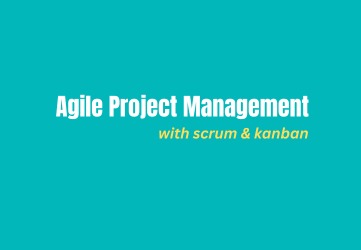What is this course about?
What is this course about?
In today’s fast-changing world, organizations must respond rapidly to market shifts, customer needs, and technological disruptions. Agile has emerged as the leading approach to deliver value faster, reduce waste, and enhance team collaboration.
This masterclass equips participants with practical knowledge to manage projects using Agile methodologies—primarily Scrum and Kanban. Through interactive workshops and real-world simulations, participants will learn how to prioritize effectively, plan sprints, manage backlogs, write user stories, and monitor project progress with agile metrics.
Who should attend this course?
This masterclass is particularly valuable for professionals involved in software delivery who find traditional project management approaches
ineffective in today’s fast-paced, change-driven environments. Ideal participants include:
- Project Managers struggling with scope creep and shifting requirements
- Software Developers and Engineers seeking better collaboration and faster delivery
- Technology Team Leads transitioning from Waterfall to Agile methods
- Scrum Masters aiming to strengthen Agile facilitation and execution
- Agile Coaches guiding teams toward continuous improvement
- Product Owners focusing on customer-centric prioritization
- Business Analysts aligning business needs with product goals
- Anyone involved in Agile transformation initiatives
How participants will benefit
How Participants Will Benefit After This Course
At the end of the training, you will have the confidence and understanding to implement Scrum in your organization
and support teams in improving their project management processes.
Hands-on Learning with Workshops
Participate in interactive group activities and real-world simulations to build practical Agile and Scrum skills.
Ready-to-Use Templates
Access professionally designed Agile and Scrum templates to streamline your implementation process.
15 Hours of Live, Instructor-Led Training
Engage in dynamic live sessions guided by experienced Agile trainers with opportunities for discussion and Q&A.
Complimentary Kaizen Training
Learn the principles of continuous improvement and how they enhance Agile and Scrum effectiveness.
Trainer-Made Course Materials
Receive curated learning resources and reference guides created by experienced Agile professionals.
Customized Learning Experience
Benefit from course adjustments based on your organization’s unique goals and challenges during the training.
Course Curriculum
This course contains 10 comprehensive modules
MODULE 1
Origins and Foundations of Agile
Understand the history behind Agile from the 1990s to the Agile Manifesto (2001).
Deep dive into the 4 values and 12 principles of the Agile Manifesto, explore why traditional
project management models fell short, and get introduced to the Agile mindset and cultural shift in organizations.
MODULE 2
Scrum Framework Essentials
Learn about Scrum roles (Product Owner, Scrum Master, Development Team), Scrum events
(Sprint, Daily Scrum, Sprint Planning, Sprint Review & Retrospective), and Scrum artifacts
(Product Backlog, Sprint Backlog, Increment). Understand time-boxing and transparency in Scrum.
MODULE 3
Product Thinking & Roadmap Prioritization
Craft and refine a Product Vision and Product Roadmap. Understand MVP and product-market fit,
and learn prioritization techniques like MoSCoW, WSJF, Kano, and Value vs Effort matrix.
Workshop: Build your own Product Roadmap using MoSCoW or Value/Effort Matrix.
MODULE 4
Product Backlog Management
Explore the DEEP characteristics of a good backlog (Detailed, Estimated, Emergent, Prioritized).
Learn the Product Owner’s role in backlog grooming, splitting and refining backlog items, and ensuring continuous backlog evolution.
MODULE 5
Introduction to Kanban for Flow Optimization
Learn the principles of Kanban: Visualize Work, Limit WIP, and Manage Flow.
Set up Kanban boards with columns, cards, and swimlanes, understand WIP limits,
and compare when to use Kanban versus Scrum for optimizing flow.
MODULE 6
Agile Estimation with Story Points
Master writing effective user stories and learn relative vs absolute estimation.
Practice estimation techniques like Planning Poker and T-shirt sizing.
Understand velocity, team capacity planning, and estimation anti-patterns to avoid.
MODULE 7
Sprint Planning and Commitment
Learn to set clear sprint goals, perform capacity-based planning,
select and commit to user stories, and apply the Definition of Ready (DoR) with technical considerations for successful sprint execution.
MODULE 8
Agile Execution & Monitoring Metrics
Explore effective daily standups, impediment tracking, and agile metrics like Velocity, Burndown, Burnup, and CFD.
Learn to use tools like Jira and Trello for dashboards, and practice inspecting and adapting during execution.
MODULE 9
Servant Leadership in Agile Teams
Understand the philosophy of Servant Leadership and the shift from command-and-control to empower-and-support mindset.
Learn how Scrum Masters enable trust, autonomy, and ownership while managing conflict and fostering team growth.
MODULE 10
Sprint Closure and Continuous Improvement
Master Sprint Review and Retrospective practices.
Apply techniques like Start/Stop/Continue, 4Ls, and Mad/Sad/Glad formats to identify action points, drive reflection, and promote continuous learning within teams.
Frequently Asked Questions
No frequently asked questions for this course.




